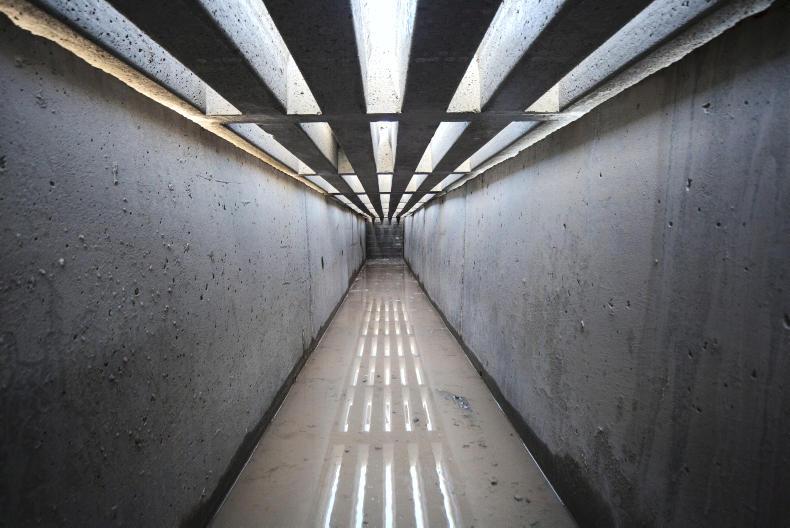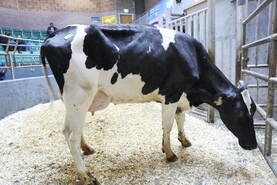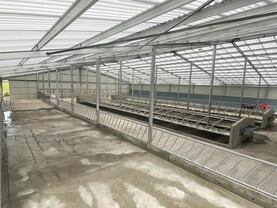Slatted tanks are the most common form of slurry storage on Irish farms. Like the other options in this Focus, they are covered under TAMS II grant aid. The building specifications for concrete tanks is listed on the Department’s website under S123. The main points in this specification include:
Concrete must be purchased on the basis of a characteristic 28-day cube crushing strength of 37N/mm2.The floor slab must be not less than 225mm thick throughout. It must extend 250mm outside the walls.Walls thickness must be 225mm minimum, or 400mm minimum where tank walls are to support super-structure and slats.All tanks must be provided with facilities for the full agitation of slurry from points outside the building. Below we have listed some of the advantages and disadvantages of using slatted tanks as a slurry storage option on the farm. Advantages of slatted tanks
The slats offer a ready-made floor for housing animals. Some county councils prefer to give planning permission for concrete tanks rather than other slurry storage options.Possibility of extending the tank to increase capacity in the future.Long working life. Disadvantages of concrete tanks
It is an expensive option.Dig out, fill and hard-core costs.Removed soil must go somewhere and there is a cost for this. If the tank is not covered, a safety fence is required and this can be costly.Costs
To try to illustrate the costs involved in building slatted tanks, we have chosen four scenarios – indoor slatted tanks for 16 and 20 weeks’ storage and outdoor slatted tanks for 16 and 20 weeks’ storage. The freeboard for indoor tanks is 0.2m and 0.3m for outdoor tanks. Freeboard is extra depth in the tank to provide some extra capacity over and above the capacity required for compliance.
In order to comply with the nitrates directive, the minimum storage periods throughout the country are – 16, 18, 20 and 22 weeks. Net slurry storage requirements for these storage periods are: 5.28m3, 5.94m3, 6.6m3 and 7.26m3/cow, respectively. After this past winter and spring, it would seem prudent to provide extra storage of four weeks or so, over and above what is mandatory. This will provide more capacity in a bad spring and will allow better slurry management even when weather conditions are normal.
A rainfall figure of 23mm per week for the outdoor tanks was used. The rain falling directly on the tanks was only used in the calculations. It does not include rainfall collected from concrete beside the tank or, for example, from outdoor cubicle areas. The rain falling on these areas can be calculated by multiplying the area involved by the storage period by the rainfall per week for the particular county. The rainfall figures in the nitrates directive vary by county – from 17mm to 45mm per week. It follows that outdoor tanks in the counties with higher rainfall will need to be much bigger and will cost more as a result. These counties tend to have the longer storage periods also, increasing capacity requirement even more.
All the costs are based on the TAMS II reference costs. Useful unit conversions are: 1m3 =1,000 litres = 220 gallons, 1m = 1,000mm = 3.281ft.
The tables show calculations of storage requirements and costs for 50, 75, 100, 125, 150 and 200 dairy cows. The net capacity is 5.28m3 per cow for 16 weeks’ storage and 6.6m3 for 20 weeks’, regardless of the storage method. The effect of extra freeboard and rainfall with outdoor tanks can be seen by comparing the total capacity figures for indoor and outdoor tanks.
The total costs shown have been calculated by multiplying the cow numbers by the total capacity by the relevant TAMS II reference costs for reinforced concrete tanks. The cost of the slats/agitation points is also included at an average price of €60 per square metre. All costs are excluding VAT.
The storage costs per m3 and per cow are shown in the tables also. By comparing these within and between the tables it gives a good handle on the effect of storage period and indoor v outdoor storage on costs. The net storage depth is increased by going for 2.7m deep for outdoor tanks, ie the effect of rainfall is reduced, which also reduces the cost per cow in the order of €35 to €40 per cow (not shown in tables). Economies of scale can also be seen from the cost per m3 and cost per cow figures. The cost per m3 and per cow does not vary substantially for slatted tanks as tank size increases, so scale has no major benefit in reducing costs compared with other storage systems. This means that for anyone providing slurry storage for say, up to and over 100 cows, slats are the most attractive option.
Single tanks are more costly to construct than double tanks and this effect is shown with one example at the bottom of each table. The effect of this is substantial. However, the tank type chosen should be based on needs and suitability and not just on costs alone.
Slatted tanks are the most common form of slurry storage on Irish farms. Like the other options in this Focus, they are covered under TAMS II grant aid. The building specifications for concrete tanks is listed on the Department’s website under S123. The main points in this specification include:
Concrete must be purchased on the basis of a characteristic 28-day cube crushing strength of 37N/mm2.The floor slab must be not less than 225mm thick throughout. It must extend 250mm outside the walls.Walls thickness must be 225mm minimum, or 400mm minimum where tank walls are to support super-structure and slats.All tanks must be provided with facilities for the full agitation of slurry from points outside the building. Below we have listed some of the advantages and disadvantages of using slatted tanks as a slurry storage option on the farm. Advantages of slatted tanks
The slats offer a ready-made floor for housing animals. Some county councils prefer to give planning permission for concrete tanks rather than other slurry storage options.Possibility of extending the tank to increase capacity in the future.Long working life. Disadvantages of concrete tanks
It is an expensive option.Dig out, fill and hard-core costs.Removed soil must go somewhere and there is a cost for this. If the tank is not covered, a safety fence is required and this can be costly.Costs
To try to illustrate the costs involved in building slatted tanks, we have chosen four scenarios – indoor slatted tanks for 16 and 20 weeks’ storage and outdoor slatted tanks for 16 and 20 weeks’ storage. The freeboard for indoor tanks is 0.2m and 0.3m for outdoor tanks. Freeboard is extra depth in the tank to provide some extra capacity over and above the capacity required for compliance.
In order to comply with the nitrates directive, the minimum storage periods throughout the country are – 16, 18, 20 and 22 weeks. Net slurry storage requirements for these storage periods are: 5.28m3, 5.94m3, 6.6m3 and 7.26m3/cow, respectively. After this past winter and spring, it would seem prudent to provide extra storage of four weeks or so, over and above what is mandatory. This will provide more capacity in a bad spring and will allow better slurry management even when weather conditions are normal.
A rainfall figure of 23mm per week for the outdoor tanks was used. The rain falling directly on the tanks was only used in the calculations. It does not include rainfall collected from concrete beside the tank or, for example, from outdoor cubicle areas. The rain falling on these areas can be calculated by multiplying the area involved by the storage period by the rainfall per week for the particular county. The rainfall figures in the nitrates directive vary by county – from 17mm to 45mm per week. It follows that outdoor tanks in the counties with higher rainfall will need to be much bigger and will cost more as a result. These counties tend to have the longer storage periods also, increasing capacity requirement even more.
All the costs are based on the TAMS II reference costs. Useful unit conversions are: 1m3 =1,000 litres = 220 gallons, 1m = 1,000mm = 3.281ft.
The tables show calculations of storage requirements and costs for 50, 75, 100, 125, 150 and 200 dairy cows. The net capacity is 5.28m3 per cow for 16 weeks’ storage and 6.6m3 for 20 weeks’, regardless of the storage method. The effect of extra freeboard and rainfall with outdoor tanks can be seen by comparing the total capacity figures for indoor and outdoor tanks.
The total costs shown have been calculated by multiplying the cow numbers by the total capacity by the relevant TAMS II reference costs for reinforced concrete tanks. The cost of the slats/agitation points is also included at an average price of €60 per square metre. All costs are excluding VAT.
The storage costs per m3 and per cow are shown in the tables also. By comparing these within and between the tables it gives a good handle on the effect of storage period and indoor v outdoor storage on costs. The net storage depth is increased by going for 2.7m deep for outdoor tanks, ie the effect of rainfall is reduced, which also reduces the cost per cow in the order of €35 to €40 per cow (not shown in tables). Economies of scale can also be seen from the cost per m3 and cost per cow figures. The cost per m3 and per cow does not vary substantially for slatted tanks as tank size increases, so scale has no major benefit in reducing costs compared with other storage systems. This means that for anyone providing slurry storage for say, up to and over 100 cows, slats are the most attractive option.
Single tanks are more costly to construct than double tanks and this effect is shown with one example at the bottom of each table. The effect of this is substantial. However, the tank type chosen should be based on needs and suitability and not just on costs alone.






 This is a subscriber-only article
This is a subscriber-only article










SHARING OPTIONS: